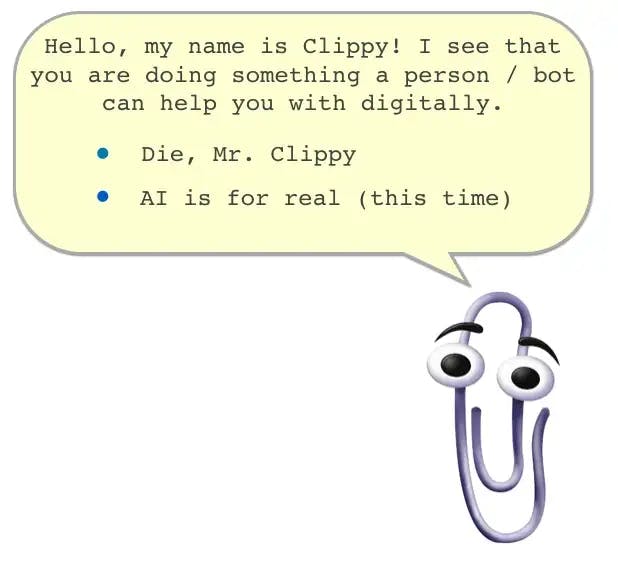
Clippy’s Revenge — Smart Messaging as Platform Shift
A number of people have written about why messaging matters, from essays on conversational commerce, to lists of invisible apps, to coining the term Assistant-as-a-Service. No comment on the acronym. My partners Josh and Sarah have talked about our investment in Operator and GIFs / messaging-first communication.
Yesterday, Slack made a bunch of announcements about the “platform” and “chat app” aspects of their fast growing and much-beloved messaging platform, and today Messenger announced big service integrations (with Uber and Lyft). It seemed like a good time to jot down some of my thoughts around:
- why messaging is an increasingly dominant way to engage on smartphones — with people, with service providers, and with software
- where I see opportunity for new players vs. platform expansion
- whether the economics are good
- who’s playing for the opportunity now
Mostly, We Write Text to One Another
My digital life is pretty fragmented, but much of it is spent in a messaging interface. In the span of thirty minutes, I’ll be on iMessage, Outlook, or Slack with my partners (sometimes all at the same time) while also co-editing and discussing docs in Quip. My friends get ahold of me through SMS, WeChat, FB Messenger (and occasionally Twitter DM, if we’re internet friends).
Here’s my actual data:
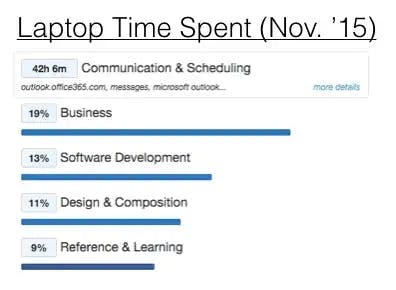
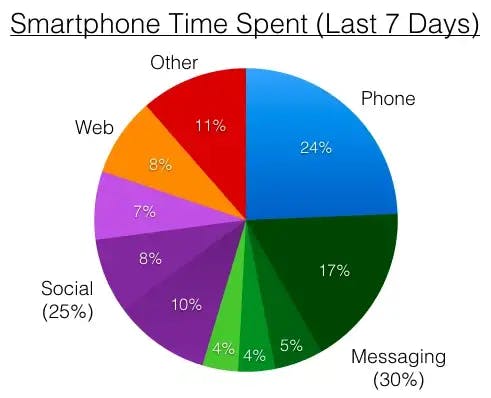
Reported with RescueTime, data collected with iOS battery life utility.
If we take college students as a leading indicator, I’m not alone. In 2014, college students (at least in this interesting study at Baylor) spent ~9 hours a day on their smartphones. Of those 9 hours, almost 30% of that time (2.4 hours) was spent either texting or emailing. Messaging has become the dominant digital experience for many young people.

Average number of minutes per day engaging in smartphone activities. J Behav Addict. 2014 Dec; 3(4).
Some are arguing no UI will be the only UI (basically, the GUI goes away and all apps will becoming messaging services). I disagree — it feels quite obvious to me that sometimes you want to read written content, or scroll through photos, write code, or build a spreadsheet…or any of the million things we do in software that don’t translate.
It is also obvious that these platforms are a new center of gravity for the current phase of mobile internet.
This is partly because it’s just a natural UX mode for smartphones. It’s also because the popular messaging clients (mostly FB and WeChat, potentially Slack) have been smart enough to develop ecosystems that trade their distribution power and real estate on your phone for third party invented features, behaviors and content that, in turn, increase their platform’s relevance and stickiness.

But there’s another, more subtle reason for the rising profile of messaging.
Messaging has the potential to be the command line for normal humans.
If you’re a developer, you often prefer the command line because it is often faster, more powerful, and feels familiar across systems. We can make philosophical arguments about continued use of the command line being a symptom of failed GUIs and lack of application integration, but that’s the reality of the mobile world. Switching costs are high, interfaces aren’t perfect. Why hunt through menus in different apps if you can just /slashcommand?
I complained to my partner John Lilly a few years ago that Siri and Google Now (ignoring the voice recognition aspect and just taking it as a text control interface) felt like a command line without unix conventions — you weren’t sure what worked, which is frustrating and stressful. Those conventions, in the form of /slash commands on Slack and address triggers in FB Messenger, are just beginning to emerge.

/slash commands in Slack
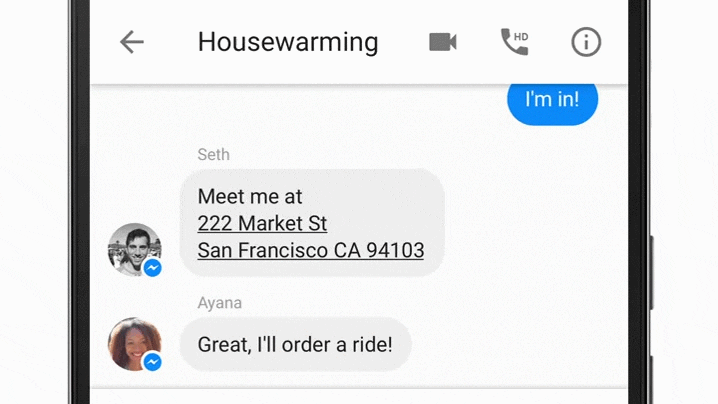
ordering an Uber in Messenger
Far from disappearing, UX is key in messaging systems, and we’re just now getting better at it. It won’t be purely natural language — soon users will know Slack-Fu and Messenger-Fu (like they know Google-Fu today) and it will make them powerful.
Where will the value accrue — to existing platforms, or to new players?
This is a question entrepreneurs and their backers have to answer when they see this kind of shift. A few reasons I think independent businesses could be built here:
First, winning engagement is the only thing that matters to the platforms, and the messaging war is not yet won. For now, incentives are aligned — developers help differentiate platforms, so the platform will support the developers. Slack is working (with Howdy) on botkit, encouraging app discovery through the Slack App Directory, and co-investing in startups and integrations with the $80M Slack Fund.
Two, enabling conversationally-driven, remote knowledge work across different verticals involves too many communities to be aggregated (and in some cases automated) by one company. It would be challenging for one team to acquire physical trainers, e-commerce businesses, QA workers, researchers, local businesses, lawyers and doctors. Agent acquisition in many communities will likely be faster and more efficient if a verticalized company attacks it.
Three, many service areas must be automated to be attractively priced, and constrained domains will support that automation. If it were cost effective to service every customer support request, Comcast wouldn’t be such a pain in the ass to get ahold of. Software companies protective of their >80% gross margins are even less willing than Comcast to employ mass workforces. They prefer to either enable independent entrepreneurs (Uber today) or automate out their workforces (Uber in 5-10 years).
Messaging being asynchronous offers parallelization, flexibility and load-balancing benefits even without automation (for example, an agent can work with 3 different clients at once).

Messaging enables parallel human processing
That being said, unsurprisingly, many technologists working in this area have a basic plan of 1) delivering an abstract service to the end customer using human agents, and 2) collecting data on the interactions to do smart routing / agent matching / super-agent enablement, and 3) possibly progress to some level of AI replacing the agent workforce.

Notice the arrows are bidirectional on the above spectrum — while some services will progress rightward in their automation and lower their cost to serve, others will remain only marginally impacted.
Modeling conversational behavior today is most effective within narrow domains. What a user will ask a lawyer has a very different surface area than what they will ask a doctor, an executive assistant, a personal shopper, and the Comcast customer service rep. New entrants who focus on a narrow domain can potentially make faster progress in their model training.
Finally, messaging is far from invisible — there is UX, brand and varying levels of trust in agent services. I would want to ask Facebook M, “What are my friends doing this weekend that I would find fun?,” but not “Please diagnose my child’s medical issue.” I might eventually ping the native SlackBot to “summarize what my team worked on today,” but not “What camera should I buy my mother for Christmas?” That feels like something you can ask Operator.
Can these businesses make money?
When thinking about the quality of a SaaS business at Greylock, we often talk about sales efficiency, your Cost-to-Serve vs. ASP (Average Selling Price). The framework at its most basic says that your ASP per customer needs to at least match (and have a path to grow and exceed) the cost to market and sell to that customer.
How does this relate to Cost-to-Serve for “agent” services? It depends on the business model. If the company serves as an enabler — for example, takes a cut of the sale rather than employing the agents — then as long as 1) the customer’s willingness to pay for that service exceeds the agent’s cost of labor, and 2) your take exceeds the cost to connect the two sides of the marketplace, the business is theoretically viable. However, if the company sells an abstracted service that they deliver — for example, charging a customer a flat fee of $20 per request — then the company is on the hook for the cost of the agents, and carries the burden (and benefit) of driving the cost of labor down through increasing automation.

VC’s when they think about strong AI
The theoretical highest-value business is one where you can charge close to the value of the original human service, but carry a low-labor cost structure yourself. This feels hard to sustain in the long term — enough people are attacking this problem, and there are enough benefits to scale (of users, agents, and data), that the biggest businesses are likely those who can drive volume, not price.
Finally, a set of companies are building enabling technologies for existing businesses, rather than running the services themselves.
Who’s working on this?
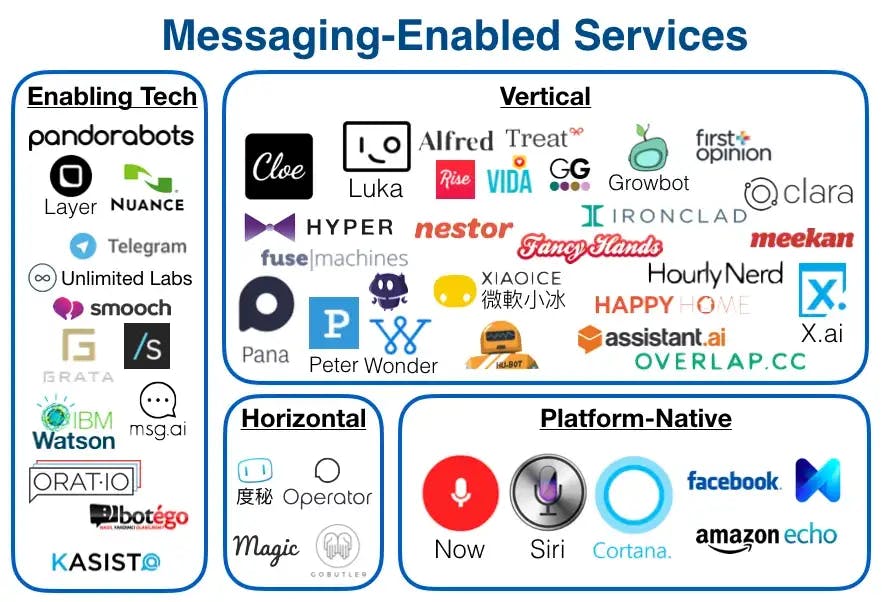
As of Dec. 2015
This (incomplete) collection of messaging-enabled services I’ve run into makes no judgement as to where they fall on the cost-to-serve spectrum above. Similarly, some of these are toys, some are platform-specific, some are cross-channel, some are standalone apps. The filter for inclusion was whether messaging is a key interaction method. Email me if you’re missing from the chart.

Hasty categorizations aside, it’s clear this area has exploded in entrepreneurial activity over the past 1–2 years.
For fun, I built a (very limited) VC bot. Her name is Ava — for anyone who has not seen Ex Machina, this is obviously an artificial being and a joke on the industry. She’s not very intelligent. She doesn’t have a fund. Greylock does not endorse her responses. I repeat — joke. But you can still try asking her for money. Or advice. Or just vent. She’ll be available to the first 1,000 messages.
Go on, text her “Hi”: 443-7MS-GAVA (443–767–4282)
Update: Ava has hit her limit! I won’t be maintaining her / paying Twilio :( but will post some of her funnier exchanges, soon!
I believe in the revenge of Clippy. But he won’t live in Microsoft Word. Email me if you do too.
This topic seeds many other related questions. For example, in another interesting (and less explored) area of opportunity, conversational interfaces expand access to tech services (to the young, old, disabled). Or — what will the global employment market impact of messaging-enabled services (with automatic translation) be? Let me know what you think!
First published on Medium.


